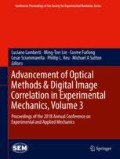Abstract
Digital Image Correlation (DIC) is a popular non-contact image-based full-field deformation measurement tool widely used in mechanics. In spite of its significant advantages, it is still primarily used as a post-processing tool due to its computational cost. In recent years, parallel computing platforms such as multi-core processors and Graphics Processing Units (GPUs) have been used to improve the speed of the DIC algorithm, with GPUs being well-suited for implementing data-parallel operations. Previous works have performed GPU-based DIC wherein each sub-image (i.e. a collection of a few pixels in the local neighborhood of a point of interest) is allocated to a single thread on the GPU, thus achieving parallelism across sub-images. However, this is not the only type of parallelism that is possible: one can also achieve parallelism within a sub-image as well as across whole images. The aim of this work is to efficiently implement 2D-DIC such that parallelism within a sub-image as well as across sub-images leads to considerable reduction in computation time. We use a heterogeneous framework consisting of an Intel Xeon octa-core CPU and an Nvidia Tesla K20C GPU card in this work. The CPU is used to handle image pre-processing, whereas the GPU is used to process four compute-intensive tasks: affine shape function computation, B-Spline interpolation, residual vector calculation and deformation vector update. Parallelization within and across sub-images is achieved in this work by efficient thread handling and use of pre-compiled BLAS libraries. In order to estimate the speedup provided by the GPU, the same four tasks were also evaluated on the octa-core CPU; a speedup of approximately 7 to 5 times was observed for a single sub-image whose size varies from 21×21 to 61×61 respectively. However, it is expected that for a larger number of sub-images, the GPU speedup will be higher and this is indeed the case: when the affine shape function computation and B-Spline interpolation steps were evaluated on 1869 21×21 pixel sub-images, the speedup was around a more impressive 453 times. Further GPU optimization as well as parallelization across image pairs is currently underway and even faster GPU-assisted DIC seems achievable.
Access this chapter
Tax calculation will be finalised at checkout
Purchases are for personal use only
Notes
- 1.
n = 0…5 for affine shape function.
References
Anderson, R.F., Kirtzic, J.S., Daescu, O.: Applying parallel design techniques to template matching with GPUs. In: International Conference on High Performance Computing for Computational Science, pp. 456–468 (2010)
Baker, S., Matthews, I.: Lucas-Kanade 20 years on: a unifying framework. Int. J. Comput. Vis. 56, 221–255 (2004)
Bing, P., Hui-Min, X., Bo-Qin, X., Fu-Long, D.: Performance of sub-pixel registration algorithms in digital image correlation. Meas. Sci. Technol. 17, 1615 (2006)
Blaber, J., Adair, B., Antoniou, A.: Ncorr: open-source 2D digital image correlation matlab software. Exp. Mech. 55, 1105–1122 (2015)
Bornert, M., Brémand, F., Doumalin, P., Dupré, J.C., Fazzini, M., Grediac, M., Hild, F., Mistou, S., Molimard, J., Orteu, J.J., Robert, L.: Assessment of digital image correlation measurement errors: methodology and results. Exp. Mech. 49, 353–370 (2009)
Cofaru, C., Philips, W., Van Paepegem, W.: Improved Newton–Raphson digital image correlation method for full-field displacement and strain calculation. Appl. Opt. 49, 6472–6484 (2010)
Gates, M., Heath, M.T., Lambros, J.: High-performance hybrid CPU and GPU parallel algorithm for digital volume correlation. Int. J. High Perform. Comput. Appl. 29, 92–106 (2015)
Le Besnerais, G., Le Sant, Y., Lévêque, D.: Fast and dense 2D and 3D displacement field estimation by a highly parallel image correlation algorithm. Strain 52, 286–306 (2016)
Owens, J.D., Houston, M., Luebke, D., Green, S., Stone, J.E., Phillips, J.C.: GPU computing. Proc. IEEE 96, 879–899 (2008)
Pan, B., Li, K.: A fast digital image correlation method for deformation measurement. Opt. Lasers Eng. 49, 841–847 (2011)
Pan, B., Tian, L.: Superfast robust digital image correlation analysis with parallel computing. Opt. Eng. 54, 034106 (2015)
Pan, B., Wang, B.: Digital image correlation with enhanced accuracy and efficiency: a comparison of two subpixel registration algorithms. Exp. Mech. 56, 1395–1409 (2016)
Shao, X., Dai, X., He, X.: Noise robustness and parallel computation of the inverse compositional Gauss–Newton algorithm in digital image correlation. Opt. Lasers Eng. 71, 9–19 (2015)
Sutton, M.A., Orteu, J.J., Schreier, H.: Image Correlation for Shape, Motion and Deformation Measurements: Basic Concepts, Theory and Applications. Springer, Berlin (2009)
Wang, Z., Wang, S., Wang, Z.: An analysis on computational load of DIC based on Newton–Raphson scheme. Opt. Lasers Eng. 52, 61–65 (2014)
Wu, R., Kong, C., Li, K., Zhang, D.: Real-time digital image correlation for dynamic strain measurement. Exp. Mech. 56, 833–843 (2016)
Zhang, L., Wang, T., Jiang, Z., Kemao, Q., Liu, Y., Tang, L., Dong, S.: High accuracy digital image correlation powered by GPU-based parallel computing. Opt. Lasers Eng. 69, 7–12 (2015)
Author information
Authors and Affiliations
Corresponding author
Editor information
Editors and Affiliations
Rights and permissions
Copyright information
© 2019 The Society for Experimental Mechanics, Inc.
About this paper
Cite this paper
Thiagu, M., Subramanian, S.J., Nasre, R. (2019). Fast, Sub-pixel Accurate Digital Image Correlation Algorithm Powered by Heterogeneous (CPU-GPU) Framework. In: Lamberti, L., Lin, MT., Furlong, C., Sciammarella, C., Reu, P., Sutton, M. (eds) Advancement of Optical Methods & Digital Image Correlation in Experimental Mechanics, Volume 3. Conference Proceedings of the Society for Experimental Mechanics Series. Springer, Cham. https://doi.org/10.1007/978-3-319-97481-1_13
Download citation
DOI: https://doi.org/10.1007/978-3-319-97481-1_13
Published:
Publisher Name: Springer, Cham
Print ISBN: 978-3-319-97480-4
Online ISBN: 978-3-319-97481-1
eBook Packages: EngineeringEngineering (R0)

